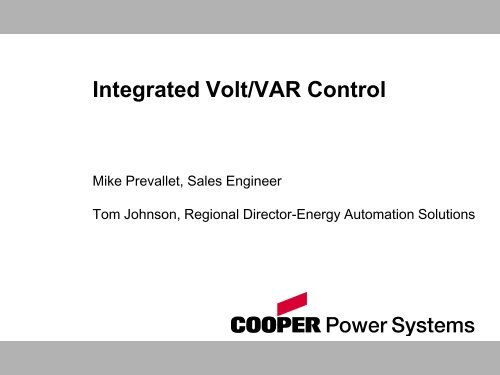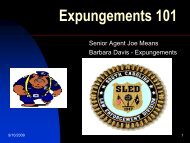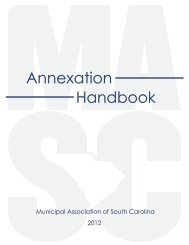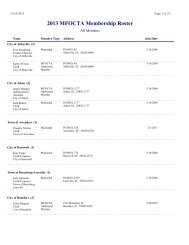Integrated Volt/VAR Control - Smart Grid News
Integrated Volt/VAR Control - Smart Grid News
Integrated Volt/VAR Control - Smart Grid News
- No tags were found...
Create successful ePaper yourself
Turn your PDF publications into a flip-book with our unique Google optimized e-Paper software.
<strong>Integrated</strong> <strong>Volt</strong>/<strong>VAR</strong> <strong>Control</strong>Mike Prevallet, Sales EngineerTom Johnson, Regional Director-Energy Automation Solutions
EAS – <strong>Smart</strong> <strong>Grid</strong> Solution LeaderCPS <strong>Control</strong>sBuilding one team focused on software, controls, and communications with250+ engineers focused on intelligent grid solutions
‣ How does <strong>Volt</strong>-Var Management benefitutilities?‣ What is <strong>Volt</strong>-Var Management?‣ Power Factor and <strong>Volt</strong>age OptimizationRequirements‣ <strong>Volt</strong>-Var input values from capacitorcontrols, voltage regulator controls andLTC; algorithm decisions‣ QuestionsAgenda3
<strong>Volt</strong>/Var Fundamentals‣ Switching capacitors on will reduce the electriccurrent (I) on the line, which will:‣ Reduces the electrical losses (I 2 R)‣ Reduces the amount of energy (kilowatt-hours) required tosupply the existing load and reduces the peak demand on thesystem‣ Indirect control of feeder voltage through CapacitorSwitching which raises the feeder voltage to:‣ Increases the real and reactive load (depending on the kind ofdevice)‣ However, this increases losses in distribution transformers4
<strong>Volt</strong>/Var Fundamentals‣Change in voltage leads to a correspondingchange in power consumption:‣a 1% change in voltage causes a change in kWusually ranging from 0.2% to 1.5%‣Effect of change of voltage on reactive power iseven more significant :‣1% change in voltage causes a change in kvarusually ranging from 2% to 6%The change in load will decay over time, but not to the value before thechange in voltage. The amount and time constant of decay depend on thecharacteristics of the circuit. **KEMA PES Conference June 2005/IEEE Transactions on Power Systems, Vol. 10, No. 2, May 1995; pp. 709-7155
<strong>Volt</strong>-Var Optimization Strategies‣<strong>VAR</strong> Optimization - Power Factor Correction‣Distribution feeder capacitor bank control provide energy lossreduction by coordinating capacitor banks control.‣Conservation <strong>Volt</strong>age Reduction (CVR)‣Coordinating voltage regulator and LTC controls to reduce feedervoltage levels provide load reduction on substations and feeders.‣<strong>Integrated</strong> <strong>Volt</strong>/<strong>VAR</strong> <strong>Control</strong> (IVVC)‣Coordinated <strong>Control</strong> of substation load tap changers, feedervoltage regulators and capacitor banks ensure <strong>VAR</strong> and voltageprofiles to optimize these benefits.‣Why Now?‣Utility Investment in communications and <strong>Smart</strong> <strong>Grid</strong> investmentlinks all facets from End-Customer to Generation, Transmissionand Distribution6
How does IVVC benefit Utilities?7
<strong>Integrated</strong> <strong>Volt</strong>/<strong>VAR</strong> Management‣Business Drivers‣Regulation imposes new requirements with the overall goalof reducing energy consumption and demand - (Reductionin peak load MW) x ($/MW to add capacity or demandcharges)‣Stimulus bill driven energy efficiency projects such asDecoupling Rates/Green initiatives - Capacity release(MW) due to reduced losses (typically a very sizable $benefit)‣Business Case‣Energy purchase savings – Reduction in Energy (MWh) toserve losses (can be a very sizable $ benefit)‣Conservation <strong>Volt</strong>age Reduction - (Reduction in LossesMWh) x ($/MWh to generate or purchase energy)8
Business Drivers‣ Pennsylvania PUC Act 129 Information:‣ Seven major Electric Distribution Companies (EDCs) inPennsylvania need to implement a plan to reduce energydemand and consumption.‣ The Act requires a 1% reduction in consumption by May 31,2011, a total of 3% reduction in consumption and a 4.5%reduction in peak demand by May 31, 2013.‣ Ohio PUC Senate Bill 221 Information:‣ Commission proposed electric distribution utilities willimplement a cost-effective energy efficiency and peakdemand reduction –‣ Bill 221 benchmarks nominal requirements for more costeffective decisions to provide energy conservation than toprovide power, electric distribution utilities must offer energysavings to lower generation purchases.9
Business Drivers‣ Snohomish CVR 2006:‣ Robert Fletcher of Snohomish PUD said conservationvoltage reduction drops the utility's voltage by 2.5 percent, to117V.‣ "That buys the average customer about 350-400 kWh peryear savings," Fletcher said. "So the net savings for ourcustomers is about $3.5 million a year.“‣ Northwest Energy Efficiency Alliance DistributionEfficiency Initiative:‣ 13 Northwest utilities consolidating research efforts validatevalue of conservation voltage reduction‣ Results from “The NEEA Phase 1 DEI Final Report” showsthat "operating a utility distribution system in the lower half ofthe acceptable voltage range (120-114 volts) saves energy,reduces demand, and reduces reactive power requirementswithout negatively impacting the customer.‣ Validated energy savings results of 1 to 3 percent totalenergy reduction, 2 to 4 percent reduction in kW demand,and a 4 to 10 percent reduction in kvar demand.”10
What is <strong>Integrated</strong> <strong>Volt</strong>-Var Management?11
System Approach to Savings‣ Local <strong>Control</strong>:‣ Power Factor‣ Load Current‣ <strong>Volt</strong>age‣ Var-Flow‣ Temperature‣ Time of Day /Season‣ Centralized Automation:‣ System Overview ofAssets‣ Conditioned BasedOptimization for -‣<strong>Volt</strong>age‣Var – power factor‣MaintenanceIntegrating the LTC’s and Regs provides Real-time <strong>Volt</strong>age & PF data tooperate the correct capacitor or regulator and optimize system efficiency12
What is <strong>Integrated</strong> <strong>Volt</strong>/<strong>VAR</strong>‣ A Flat Feeder <strong>Volt</strong>age Profile. (improved voltageprofile)‣ Unity Power Factor (minimize losses)‣ The ability change the voltage on demand– Demand Response - conservation voltagereduction‣ The ability to define roles where <strong>Volt</strong>age or PowerFactor are the primary metric based on advancealgorithms, real-time data, power flow,constraints and system dynamic needs.13
Case 1: No <strong>Volt</strong>age RegulationSubstation LTC or<strong>Volt</strong>age RegulatorsLine <strong>Volt</strong>ageRegulatorCapBank1phXFMREndCustomerGeneration & TransmissionDistributionConsumption<strong>Volt</strong>ageTargetDistance from Substation‣ <strong>Volt</strong>age drops off with distance from the substation– On-load Tap Changer on substation transformer, or substation regulators step upvoltage so that voltage at end of feeder stays within required range‣ <strong>VAR</strong> injected at substation (for inductive loads)– Either via generator or substation capacitor bank‣ Can be very difficult to manage <strong>Volt</strong>/<strong>VAR</strong> within target range on a long feeder withnumerous loads of varying types‣ Severe penalties for not maintaining power factor14
Case 2: Distributed <strong>Volt</strong>age RegulationSubstation LTC or<strong>Volt</strong>age RegulatorsLine <strong>Volt</strong>ageRegulatorLine <strong>Volt</strong>ageRegulator1phXFMREndCustomerGeneration & TransmissionDistributionConsumption<strong>Volt</strong>ageTargetDistance from Substation‣ Optimized planning for placement of Regulators – Cyme‣ Standalone <strong>Volt</strong>age Regulators added along the way keeps<strong>Volt</strong>age in a tighter range‣ Benefits– Minimize/avoid voltage violations– Improve efficiency by reducing “average voltage”15
Case 3: Traditional <strong>Volt</strong>/<strong>VAR</strong> ManagementSubstation LTC or<strong>Volt</strong>age RegulatorsLine <strong>Volt</strong>ageRegulatorCapBankLine <strong>Volt</strong>ageRegulator1phXFMREndCustomerGeneration & TransmissionDistributionConsumption<strong>Volt</strong>ageTargetDistance from Substation‣ Optimized planning for placement of Regulators and Capacitor Banks – Cyme‣ Adding capacitor banks to the system further flattens the voltage profile‣ Benefits– Minimize/avoid voltage violations– Improve efficiency by reducing “average voltage”– Improves power factor– Frees up generating capacity by injecting <strong>VAR</strong>s; reduced generation16
Case 4: <strong>Integrated</strong> <strong>Volt</strong>/<strong>VAR</strong>Substation LTC or<strong>Volt</strong>age RegulatorsLine <strong>Volt</strong>ageRegulatorsCapBankLine <strong>Volt</strong>ageRegulators1phXFMREndCustomerGeneration & TransmissionDistributionConsumption<strong>Volt</strong>ageTargetDistance from Substation‣ Optimized planning for placement of Regulators and Capacitor Banks – Cyme‣ With <strong>Integrated</strong> <strong>Volt</strong>/Var (IVVC), regulators, load tap changes and capacitorsare continuously monitored & controlled to manage power factor and voltage‣ Additional Benefits– <strong>Volt</strong>/<strong>VAR</strong> is optimized in real time for power quality and system efficiency– Utilities can perform Conservation <strong>Volt</strong>age Reduction to shed load - 1%reduction in voltage = 0.5-0.7% reduction in load17
Power Factor and <strong>Volt</strong>ageOptimization Requirements18
Functional Requirements‣ <strong>Control</strong> Set Points‣ System evaluates optimization pattern to control LTC and regulatorset points and tap positions‣ System optimizes capacitor bank statuses to flatten voltage in thedistribution to the specified target.‣ Targeted Power Factor‣ The <strong>Volt</strong>-<strong>VAR</strong> Management application evaluates how to changecapacitor bank statuses to manage feeder and substation <strong>VAR</strong> flowsas close to a specified target power factor.‣ Loss of Communications Failover / Recovery support‣ System communications support a failover and recovery scheme toinsure voltage quality is maintained when communications from theapplication to the controls fails.‣ Communications Band-Width Management‣ Measurement Communications by exception to reduce the messagetraffic in the communications network.19
Functional Requirements‣ Feeder Reconfiguration Integration‣ switch status change and data processing‣ Results in dynamic coordination of feeder capacitor banks,feeder measurement points, and substation LTCs, andregulators.‣ <strong>Volt</strong>age targets‣ Support for normal and emergency voltage targets to allowfor emergency CVR operation‣ <strong>Control</strong> Center Operations‣ Support disabling/enabling <strong>Volt</strong>/<strong>VAR</strong> Management automaticcontrol from the control center/operations desk.‣ System Integration‣ SCADA/DMS/OMS integration to support capacitor bank,LTC, and regulator supervisory control actions from thecontrol center operations desk.20
<strong>Volt</strong>-Var System Input Values21
Field HardwareCommunication Enabled – Hardwarefor voltage, Var, and substation current/watts (bias)‣ Substation Regulators‣ Substation Capacitor Banks <strong>Control</strong>s‣ Down-line (Feeder) Regulators‣ Feeder Capacitor Bank <strong>Control</strong>s‣ Medium <strong>Volt</strong>age Sensors‣ Customer Meters22
<strong>Volt</strong>/Var Management Algorithm‣IVVC Algorithm is triggered by:‣ Value limit violation‣ Periodic interval‣IVVC Algorithm Sequence of Events:‣Scan and Correlate Measurement Data Set‣Evaluate Feeder <strong>Volt</strong>age Profile and Power Factor‣Evaluate if Device control actions could improve:‣ Feeder <strong>Volt</strong>age Profile‣ Substation and Feeder Power Factor‣Calculate costs for current operating state, proposed operatingstates.‣Optimization resolves conflicts between <strong>Volt</strong>age and PowerFactor targets and minimizes the number of control actions.23
IVVC Optimization Table‣ Algorithm Resolves Constraints‣ Cost for voltage and Var used to determineoperation. Capacitor vs Regulator/LTC‣ Decision criteria to resolves voltage or <strong>VAR</strong>violation‣ The utility defines/selects resolution costs andmetrics through solution weighting24
<strong>Volt</strong>/Var Management Implementation‣Data Requirements: Data is provided in a formatted flatfile and imported to the <strong>Volt</strong>/Var Management applicationvia a standard data import script‣Static Device Attributes examples are Capacitor Bank size, LTC andRegulator static attributes: Primary and Secondary voltages, Number oftaps, max/min voltages, bandwidth‣Regulation Settings examples are Cap Bank Regulation type (<strong>Volt</strong>,Var, Time, Temp), regulation target, regulated phase are integrated in themodel‣Nominal feeder topology: examples include Cap Bank/Regulator tofeeder section, Cap Bank/Regulator to Sectionalizing Switches (SCADASwitch, Sectionalizers, Reclosers), Cap Bank/Regulator to feeder, CapBank/Regulator to substation bus, Device to control zone25
‣Integration Requirements:<strong>Volt</strong>/Var Management Requirements‣Real Time Measurement Data: <strong>Volt</strong>s, Amps, Watts andVars at each control device and each meter location‣Typically Utilities integrate with: SCADA , OMS, DMSEMS and database systems to support operational objectives forapplication status and control positions‣Sectionalizing Switch Positions: Support automatedrecoordination of feeder cap banks and regulators to theappropriate feeder and substation bus after feeder switching26
Example Architecture- IVVCFieldCommandsFieldCommandsRegulator/LTCCap <strong>Control</strong>lerRecloserAMIYUKONIVVCSERVERPI DatabaseMeter27
SummaryBusiness Drivers‣ Regulation imposes new requirementswith the overall goal of reducing energyconsumption and demand‣ Energy purchase savings‣ Increased KWh sales on improved voltageprofile‣ Stimulus bill driven energy efficiencyprojectsFunctional Objectives‣ Manage Feeder <strong>Volt</strong>age down to a settabletarget‣ Manage Feeder <strong>VAR</strong>s to a settable target‣ Flat voltage profileBusiness Objectives‣ Unity Power Factor minimizes losses andminimizes purchased KW‣ Reduced voltage profile minimizespurchased KW:‣ 1% reduction in voltage results in 0.5to 0.8% reduction in KWTechnical Requirements‣ Monitor and control substation regulatorsor LTCs (Regulator <strong>Control</strong>s)‣ Monitor and control substation and feedercapacitor banks (Cap Bank <strong>Control</strong>s)‣ Monitor end of line voltages to avoidviolations (<strong>Smart</strong> Meters, Sensors, etc.)IVVC Solutions Improve <strong>Grid</strong> Efficiency28
















